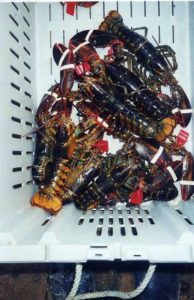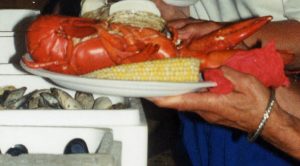


Cooking and Eating Lobsters
Are lobsters nutritious?
Lobster is one of, if not the most tasty and famous of . It is not only good, it is good for you. It has less calories, less total fat and less cholesterol (based on 100 grams of cooked product) than lean beef; whole poached eggs; and even roasted, skinless chicken breast. Lobster is also high in amino acids; potassium and magnesium; Vitamins A, B12, B6, B3 (niacin) and B2 (riboflavin); calcium and phosphorus; iron; and zinc.
How do you cook live lobster?
Boiling
Fill a large pot approximately three-quarters full of seawater or salted water (2 T of salt per quart of water). Use about 2½ quarts of water for each lobster. Bring the water to a boil. Put in the live lobsters, one at a time, cover and bring the water to a boil again. Then, lower the heat and simmer about 15 minutes for a 1- to 1¼-pound hard-shell lobster and 20 minutes for a 1½-pound hard-shell lobster. If soft shell lobsters, reduce the cooking time by 3 minutes.
Steaming
Use seawater or salted water. In a large pot, bring about 2 inches of water to a rolling boil over high heat. Drop in the live lobsters, one at a time. Leaving rubber bands on is optional. Cover and return to a boil as quickly as possible. When water returns to a boil, cook approximately 18 minutes for a 1- to 1¼-pound hard-shell lobster and 20 minutes for a 1½-pound hard-shell lobster. If the lobster has a soft shell, reduce the cooking time by 3 minutes. Lobsters will turn bright red when cooked.
Grilling
Par-boil lobsters in boiling water for 5 minutes. Remove the lobsters and immediately put into a large pot/bowl of cold water to stop the cooking. (You can drain the lobsters and store in the refrigerator if you do not plan to grill them right away.)
Using a sharp knife, slice the lobster down the middle (easiest to cut legs side up). Remove the black vein from the tail, the greenish tomalley from the body and the sand sac located near the head. Baste the lobster meat with some oil or melted butter.
Grill the lobsters flesh side down for 5 to 6 minutes, or until the flesh is just beginning to look opaque. Turn the lobsters over, baste with more oil and continue to cook for 4 to 5 minutes longer, or until the lobsters are cooked through.
What’s the difference between a hard shell and soft shell lobster?
Lobster will periodically shed their shells as they grow. This can happen as many as 25 times before they are 6-7 years old; then males shed every year and mature females every two years. When lobsters become very large molting is less frequent. After they shed they have a paper thin shell, which can take up to two months to harden, and are called soft-shell, new-shell or shedders. The debate goes on as to which is most tasty, though the soft-shell are definitely easier to crack! Either is welcome on our dinner table!
Why do lobsters twitch as they cook?
Researchers found that a few seconds after a lobster is dropped in boiling water it will begin to twitch its tail. The tail movement, which continues for approximately one minute, is part of a reflex action found in lobsters and crayfish (but not crabs). Known as the “escape response”, it is a reflex action to any sudden stimulus – a reaction that was first identified by George Johnson in 1924. The lobster is reacting to an external factor, such as an elevated water temperature.
How can you minimize the movement of a lobster when its placed in a cooking pot?
There are several methods purported to “put lobsters to sleep” so they don’t twitch their tails when cooked. These include hypnotizing, slow heating, and chilling/icing. Experiments at the University of Maine determined that:
- Boiling in the traditional manner causes a lobster to begin activity in 5-10 seconds and continue for 1 – 1 1/2 minutes.
- Hypnotizing the lobster by holding its head down and rubbing it nearly doubles the length of time it moves.
- Slow heating in salt water from room temperature results in increased activity when the water reaches a temperature of around 30°C/86°F. This activity lasts 2-3 minutes and then subsides.
- Pot steaming seems to reduce the activity of lobsters. However, lobsters at the top of the steam rack may still be alive after 20 minutes when large numbers of lobsters are being cooked at once unless the steam is retained in the pot.
- Chilling/icing before cooking, by placing the lobster on ice or in a freezer (but not freezing it) delays the onset of activity about 30 seconds and reduces the duration of movement to about 20 seconds.
Researchers believe the best way to minimize the lobster’s movement time is to chill/ice it before dropping it in water that has come to a rolling boil. Hypnotizing, slow heating, and steaming increase the length and duration of activity during cooking.
Why do lobsters turn red when you cook them?
A live lobster is greenish/black because of the many different color pigment chromatophores. When it is cooked, all the pigments are masked except for the astaxanthin, the red background pigment.
What is the white “goop” you find in the lobsters and the water after you cook them?
This is the hemolymph, often referred to as the blood of the lobster.
What is the green stuff you find in the cooked lobsters? Can you eat it?
This is the tomalley or tamali, which functions like the liver, pancreas and intestines in the lobster. Many find it delicious to eat. Recently there have been concerns about finding dioxin in tomalley. The Maine Lobster Promotion Council offers this advice to consumers and concerned citizens: “(According to the Advanced Seafood Handbook,) ‘there are no known safety considerations when it comes to eating lobster meat. However, consumers are advised not to eat the tomalley, the light green substance found in the lobster’s carapace. This is the liver and pancreas, which are thought to accumulate contaminants from the environment.’ Much like the liver of other animals, the lobster’s tomalley is the natural filter for contaminants, like dioxins, from entering the system. Finding the dioxins in the lobster tomalley is regrettable, and certainly a sign of the times in which we live. However, it is also a reassuring indication of the lobster’s natural defense system at work, keeping the lobster meat wholesome, nutritious and delicious.”
What is the red stuff you find inside along the tail of cooked lobster? Can you eat it?
This reddish “coral” as it is called is lobster roe or eggs. Some consider it a gourmet treat.
Can you get live lobster all year?
Live lobsters are usually available year-round. Fishing regulations vary from state to state in the U.S., and district to district in Canada. In Maine, lobstermen can fish year round. However, lobsters are less active as water temperature drops. Live lobsters can also be held in tidal pounds or tank storage, to be made available when the catch is slower.
